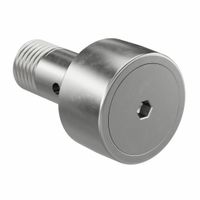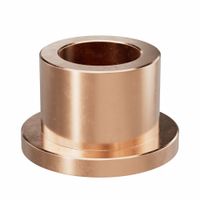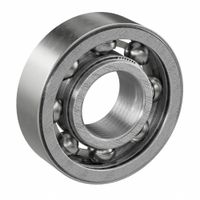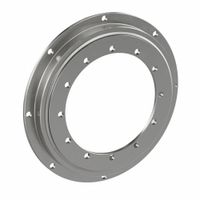Call +(254) 703 030 000 / 751 483 999 / 721 704 777
- Home
- Power Transmission
- Bearings
.....Read More
Frequently Asked Questions
What are the different types of bearings and their uses?
1. **Ball Bearings**: These are the most common type of bearings, featuring balls between two races. They are used in applications with low to moderate loads, such as in electric motors, fans, and hard drives, due to their ability to handle both radial and axial loads.
2. **Roller Bearings**: These bearings use cylindrical rollers instead of balls, providing a larger contact area. They are suitable for heavy radial loads and are used in conveyor belt rollers, large electric motors, and gearboxes.
3. **Tapered Roller Bearings**: Designed to handle large radial and axial loads, these bearings have conical rollers. They are commonly used in automotive applications, such as in wheel hubs and gearboxes.
4. **Needle Bearings**: A type of roller bearing with thin, long rollers, needle bearings are ideal for applications with limited radial space and high load capacity, like in automotive transmissions and universal joints.
5. **Spherical Roller Bearings**: These bearings can accommodate misalignment and are used in heavy-duty applications, such as in mining and construction equipment, due to their ability to handle high radial and axial loads.
6. **Thrust Bearings**: Designed to handle axial loads, thrust bearings are used in applications like automotive steering systems and rotary tables.
7. **Magnetic Bearings**: These bearings use magnetic fields to support loads without physical contact, reducing friction. They are used in high-speed applications like turbines and compressors.
8. **Fluid Bearings**: Utilizing a thin layer of liquid or gas, fluid bearings are used in high-speed, high-precision applications, such as in HDDs and high-speed turbines, due to their low friction and wear.
9. **Plain Bearings**: Also known as bushings, these bearings have no moving parts and are used in applications with low-speed and high-load conditions, such as in construction machinery and agricultural equipment.
How do bearings extend the working life of rotating parts?
Bearings extend the working life of rotating parts by reducing friction, supporting loads, and ensuring smooth motion. They minimize direct metal-to-metal contact between moving parts, which reduces wear and tear. By providing a low-friction interface, bearings decrease the energy required for movement, leading to less heat generation and lower operating temperatures. This reduction in heat helps prevent thermal expansion and material degradation, which can lead to premature failure.
Bearings also help in distributing loads evenly across the rotating parts. This load distribution prevents localized stress concentrations that can cause material fatigue and eventual failure. By supporting both radial and axial loads, bearings maintain the alignment of rotating components, ensuring consistent performance and reducing the risk of misalignment-related issues.
Additionally, bearings are designed to accommodate various operational conditions, such as high speeds, heavy loads, and harsh environments. They are often equipped with seals and lubrication systems that protect against contaminants like dust, dirt, and moisture, which can cause corrosion and abrasion. Proper lubrication reduces friction further and helps dissipate heat, extending the life of both the bearing and the rotating parts.
Moreover, bearings can absorb and dampen vibrations and shocks, protecting the machinery from dynamic stresses that could lead to damage. By maintaining the stability and precision of rotating parts, bearings contribute to the overall reliability and efficiency of mechanical systems.
In summary, bearings enhance the longevity of rotating parts by minimizing friction, distributing loads, maintaining alignment, protecting against contaminants, and absorbing vibrations, all of which contribute to reduced wear and improved performance.
What is the difference between rolling-element bearings and plain bearings?
Rolling-element bearings and plain bearings are two types of bearings used to reduce friction between moving parts.
Rolling-element bearings use balls or rollers placed between two races to support radial and axial loads. The rolling elements minimize friction by converting sliding motion into rolling motion, which significantly reduces resistance. These bearings are suitable for high-speed applications and can handle both radial and axial loads. They are commonly used in machinery, automotive, and aerospace industries. Rolling-element bearings require precise manufacturing and regular maintenance, including lubrication, to ensure optimal performance and longevity.
Plain bearings, also known as bushings or sleeve bearings, rely on sliding motion between two surfaces. They consist of a shaft rotating within a sleeve or housing, with a thin film of lubricant reducing friction. Plain bearings are simpler in design, often more cost-effective, and can accommodate larger loads and misalignments compared to rolling-element bearings. They are typically used in applications with lower speeds and where noise reduction is important, such as in household appliances and automotive suspension systems. Plain bearings require less maintenance but may have higher friction and wear rates compared to rolling-element bearings.
In summary, the main differences lie in their design, load capacity, speed suitability, maintenance requirements, and applications. Rolling-element bearings are ideal for high-speed, precision applications, while plain bearings are preferred for simplicity, cost-effectiveness, and heavy-load scenarios.
How do spherical bearings compensate for angular misalignment?
Spherical bearings are designed to accommodate angular misalignment between connected components. They consist of an inner ring with a spherical convex outside surface and an outer ring with a corresponding concave inside surface. This design allows the inner ring to rotate and pivot within the outer ring, providing a self-aligning capability.
The key to their function lies in the spherical geometry of the bearing surfaces. When misalignment occurs, the inner ring can tilt or rotate relative to the outer ring, maintaining contact over a wide range of angles. This movement is facilitated by the low-friction surfaces, often made from materials like PTFE or lubricated metals, which reduce wear and allow smooth operation.
Spherical bearings can handle both radial and axial loads while compensating for misalignment. They are particularly useful in applications where shafts or rods are subject to angular movement, such as in automotive suspensions, heavy machinery, and aerospace components. By allowing for angular displacement, spherical bearings prevent stress concentrations and potential damage to the connected parts, enhancing the longevity and reliability of the system.
In summary, spherical bearings compensate for angular misalignment through their unique design, which allows the inner ring to pivot within the outer ring, maintaining alignment and reducing stress on the system.
What are cam followers and track rollers used for?
Cam followers and track rollers are specialized types of bearings used in various mechanical applications to facilitate smooth motion and reduce friction between moving parts.
Cam followers are designed to follow the cam lobe profiles in cam mechanisms, converting rotary motion into linear motion. They are commonly used in automated machinery, conveyors, and material handling systems. Cam followers consist of a thick-walled outer ring that can withstand high radial loads, a stud or yoke for mounting, and needle or cylindrical rollers to minimize friction. They are essential in applications where precise motion control is required, such as in textile machinery, packaging equipment, and automotive engines.
Track rollers, on the other hand, are used to support and guide linear motion along a defined path or track. They are employed in applications where components need to move smoothly along rails or tracks, such as in sliding doors, conveyor systems, and robotic arms. Track rollers are designed to handle both radial and axial loads, ensuring stability and reliability in motion. They come in various configurations, including stud-type and yoke-type, and can be equipped with seals to protect against contaminants.
Both cam followers and track rollers are crucial in reducing wear and tear on machinery, enhancing performance, and extending the lifespan of equipment. They are selected based on load capacity, speed, environmental conditions, and specific application requirements. Their robust construction and ability to handle dynamic loads make them indispensable in industries like manufacturing, automotive, aerospace, and logistics.
How do slewing rings support loads in multiple directions?
Slewing rings, also known as slewing bearings, are designed to support loads in multiple directions, including axial, radial, and moment loads. They achieve this through their unique construction, which typically consists of an inner ring, an outer ring, and rolling elements such as balls or rollers. These components are arranged in a way that allows the slewing ring to accommodate complex load combinations.
1. **Axial Loads**: These are loads applied parallel to the axis of rotation. Slewing rings support axial loads through the contact between the rolling elements and the raceways of the inner and outer rings. The rolling elements distribute the load evenly across the raceways, allowing the bearing to handle significant axial forces.
2. **Radial Loads**: These are loads applied perpendicular to the axis of rotation. The rolling elements, positioned between the inner and outer rings, provide resistance to radial loads. The design ensures that the load is transferred efficiently from the outer ring to the inner ring, maintaining stability and performance.
3. **Moment Loads**: These are tilting or overturning forces that can cause bending. Slewing rings are particularly effective at handling moment loads due to their large diameter and the distribution of rolling elements around the circumference. This configuration provides a broad base of support, allowing the bearing to resist tilting forces and maintain alignment.
The combination of these capabilities makes slewing rings ideal for applications requiring rotational movement and load support in multiple directions, such as cranes, excavators, wind turbines, and radar antennas. Their ability to handle complex load scenarios with precision and reliability is a key factor in their widespread use in heavy machinery and equipment.
What is the purpose of bearing adapters and withdrawal sleeves?
Bearing adapters and withdrawal sleeves are essential components used in the installation and removal of bearings on shafts, particularly in applications involving tapered shafts or tapered bore bearings.
**Bearing Adapters:**
1. **Purpose:** Bearing adapters are used to mount bearings with a tapered bore onto a cylindrical shaft. They facilitate the secure and precise positioning of the bearing on the shaft.
2. **Functionality:** The adapter sleeve is placed on the shaft, and the bearing is then mounted onto the sleeve. By tightening a lock nut, the sleeve is drawn into the bearing, expanding it and securing it onto the shaft.
3. **Advantages:** They allow for easy mounting and dismounting of bearings, accommodate slight misalignments, and enable the use of standard cylindrical shafts with tapered bore bearings.
**Withdrawal Sleeves:**
1. **Purpose:** Withdrawal sleeves are used for dismounting bearings from a shaft, particularly when the bearing is mounted on a tapered shaft or adapter sleeve.
2. **Functionality:** The withdrawal sleeve is inserted between the bearing and the shaft. By tightening a lock nut or using hydraulic pressure, the sleeve is pulled out, allowing the bearing to be removed without damaging the shaft or bearing.
3. **Advantages:** They simplify the removal process, reduce the risk of damage during dismounting, and are reusable, making them cost-effective for maintenance operations.
Both components are crucial for ensuring the longevity and reliability of machinery by facilitating proper bearing installation and removal, thus minimizing downtime and maintenance costs.
How do bearing heaters work to expand the bore diameter?
Bearing heaters work by using thermal expansion to increase the bore diameter of a bearing, allowing it to be easily mounted onto a shaft. When a bearing is heated, the metal expands uniformly. This expansion increases the diameter of the bore, temporarily enlarging it so that it can slip over the shaft with minimal force.
There are several types of bearing heaters, including induction heaters, electric hot plates, and ovens. Induction heaters are the most common and efficient. They use electromagnetic induction to generate heat within the bearing. The heater creates an alternating magnetic field, which induces eddy currents in the metal of the bearing. These currents generate heat due to the metal's resistance, causing the bearing to expand.
The process is controlled to ensure the bearing is heated evenly and to a specific temperature, usually between 80°C and 120°C (176°F to 248°F), depending on the bearing size and material. This temperature range is sufficient to expand the bearing without altering its metallurgical properties or causing damage.
Once the bearing reaches the desired temperature, it is quickly removed from the heater and placed onto the shaft. As the bearing cools, it contracts and forms a tight interference fit with the shaft, ensuring secure and precise mounting.
Using a bearing heater is advantageous because it reduces the risk of damage compared to mechanical methods, such as hammering, and ensures a uniform expansion, which is critical for maintaining the bearing's integrity and performance.
Why is proper lubrication important for bearings?
Proper lubrication is crucial for bearings as it significantly enhances their performance and longevity. Lubrication reduces friction between the moving parts of the bearing, minimizing wear and tear. This reduction in friction leads to lower operating temperatures, which is essential because excessive heat can degrade the bearing material and the lubricant itself, leading to premature failure.
Lubrication also acts as a protective barrier against corrosion and contamination. Bearings often operate in environments where they are exposed to moisture, dust, and other contaminants. A proper lubricant forms a seal that prevents these harmful elements from reaching the bearing surfaces, thereby reducing the risk of corrosion and abrasive wear.
Moreover, lubrication helps in distributing loads evenly across the bearing surfaces. This even distribution is vital for preventing localized stress concentrations that can cause pitting and spalling, which are common modes of bearing failure. By ensuring a consistent lubricant film, the bearing can handle higher loads and operate more smoothly.
Additionally, lubrication can dampen vibrations and noise, contributing to quieter and more stable machinery operation. This is particularly important in precision applications where noise and vibration can affect performance and accuracy.
In summary, proper lubrication is essential for reducing friction, preventing wear, protecting against contaminants, distributing loads, and minimizing noise and vibration. These benefits collectively enhance the reliability, efficiency, and lifespan of bearings, making lubrication a critical aspect of bearing maintenance and operation.
How do bearing packers ensure long service life?
Bearing packers ensure long service life by effectively applying the right amount and type of lubricant to the bearings, which reduces friction, wear, and heat generation. Proper lubrication is crucial for minimizing metal-to-metal contact and preventing corrosion, which can lead to premature bearing failure.
1. **Consistent Lubrication**: Bearing packers provide a uniform and consistent application of grease, ensuring that all parts of the bearing are adequately lubricated. This consistency helps in maintaining a protective film over the bearing surfaces, reducing friction and wear.
2. **Contamination Prevention**: By using bearing packers, the risk of contamination from dirt, dust, and moisture is minimized. Contaminants can cause abrasive wear and corrosion, leading to bearing failure. Proper packing ensures that the lubricant acts as a barrier against these harmful elements.
3. **Optimal Grease Quantity**: Bearing packers help in applying the correct amount of grease. Over-packing can lead to excessive heat build-up, while under-packing can result in insufficient lubrication. Both scenarios can reduce bearing life. Bearing packers ensure the optimal grease quantity is used, balancing lubrication and heat dissipation.
4. **Improved Efficiency**: With the right lubrication, bearings operate more efficiently, reducing energy consumption and operational costs. This efficiency contributes to a longer service life by minimizing the stress and strain on the bearing components.
5. **Reduced Maintenance**: Properly packed bearings require less frequent maintenance, as the risk of premature failure is reduced. This not only extends the service life of the bearings but also lowers maintenance costs and downtime.
By ensuring that bearings are properly lubricated and protected from contaminants, bearing packers play a critical role in extending the service life of bearings, enhancing performance, and reducing operational costs.






